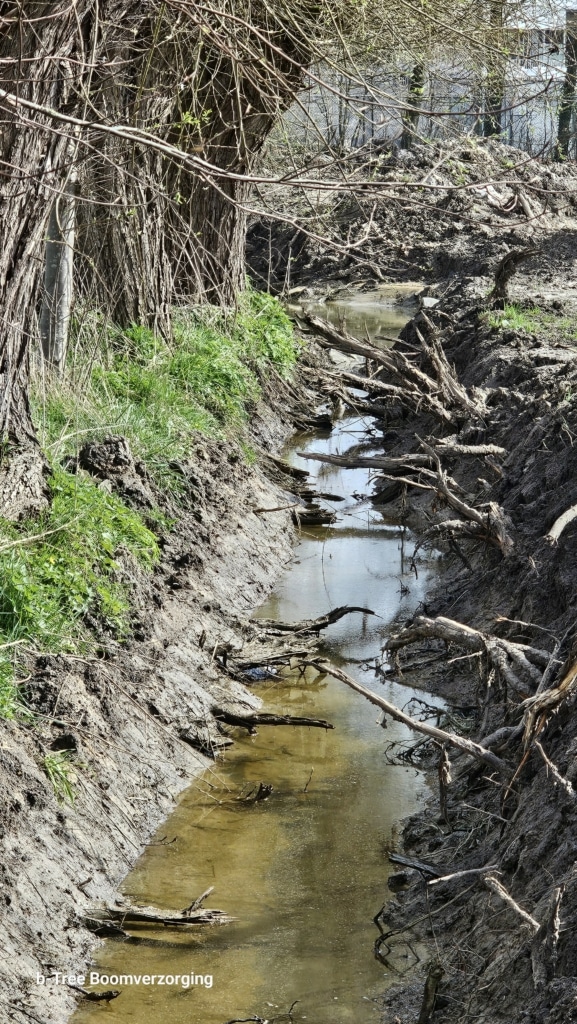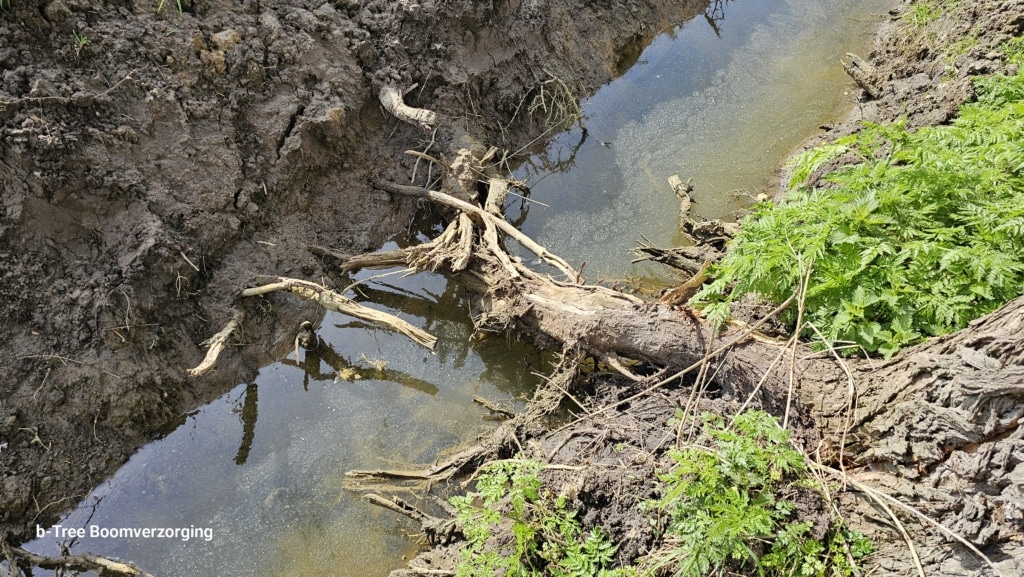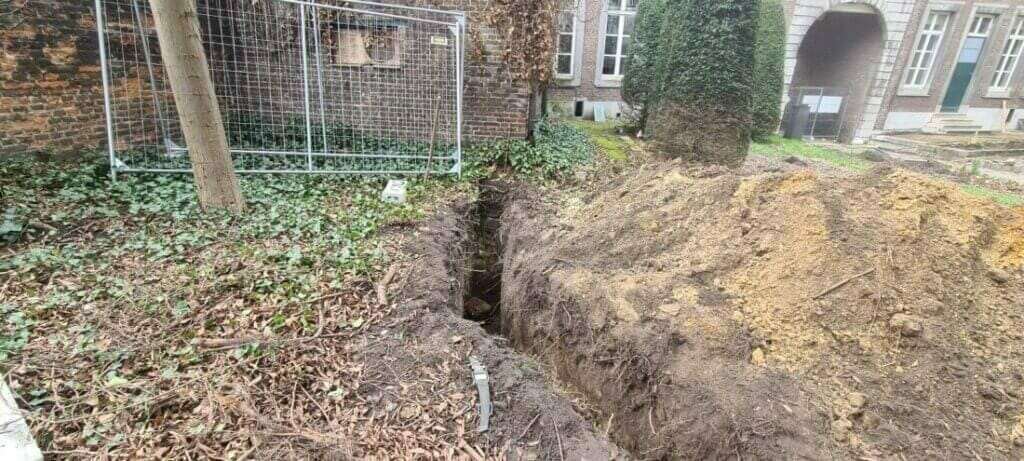Root damage to trees and how to prevent it
Effect of root damage on trees, and how to prevent it
Root damage to trees can be significant and has both morphological and physiological consequences for the trees. Moreover, it is important to know how to prevent such damage.
Below we will explain in detail why root damage is so bad for the well-being of the tree. And what damage the tree will sustain in the long term.
As humans, we often think too short term when it comes to trees. If left untouched, an oak can live for 500 years. If root damage is caused and it is not too extensive, the tree can only show the consequences above ground 10 years later or 20 years later. That is why we would like to inform you what root damage in trees means on a morphological level (its structure) and physiological level (its functioning).
At the bottom of this page, specific attention has been paid to preventing root damage during earthworks and garden construction. Because this is a common situation that often causes serious root damage.
Morphological explanation why root damage is bad
Root damage can lead to various morphological changes in trees. This mainly changes the structure (or structure) of their root system.
When you damage the roots, this results in reduced stability of the tree. This means that the tree is more sensitive to wind throw (uprooting). This makes it easier for the tree to fall over. Roots are thick roots that are located close to the base of the tree. And above all, ensure support and anchoring in the ground. They can be very thick, up to more than 30 cm in diameter in large trees.
Root damage to exploration roots and exploitation roots, on the other hand, results in reduced efficiency in water and nutrient uptake.
Exploration roots are roots that almost always run straight, away from the tree, to explore the soil. Looking for nutrients (humus-rich soil for example). When they reach a suitable soil, this root will transition to an exploitation root. A set of small and finely branched roots that then locally colonize the soil. To absorb nutrients and moisture.
Root damage to a tree disrupts its physiological functioning
Root damage affects trees' physiological processes, including water and nutrient uptake, photosynthesis and breathing.
Damaged roots will reduce the efficiency of water transport and reduce nutrient intake. Which leads to reduced growth and vitality of the tree.
In addition, root damage will affect the production of root exudates, such as the sugars produced in the leaves. Who play a crucial role in the communication with soil microorganisms and the mutual availability of nutrients, both for the tree and soil life (IC Meier et al., 2019).
Examples of how root damage can occur
Root damage to trees can occur in various ways, often as a result of human activities or natural factors.
Here are some common examples.
Human activities
Unfortunately, many people are unaware of the seriousness of causing root damage. And we will come back to this later. But root damage to trees often occurs due to human activities.
Please note that you can often prevent this damage by yourself protect trees before you start building. So you know what's going on in the soil. And what needs, read how many roots the existing trees need as a minimum. To remain both stable and healthy. And where these roots are located.
Building and construction work
Excavating, laying foundations, digging cable trenches, and driving heavy machinery over the root zone can cause physical damage to roots. Such as pulling over or breaking roots. And even tearing out roots right up to the trunk. Heavy machinery causes damage not only through physical damage. But also through soil compaction. Where oxygen deficiency occurs in the soil and subsequently root death.
All this damage disrupts water and nutrient uptake and can lead to the destabilization of trees.
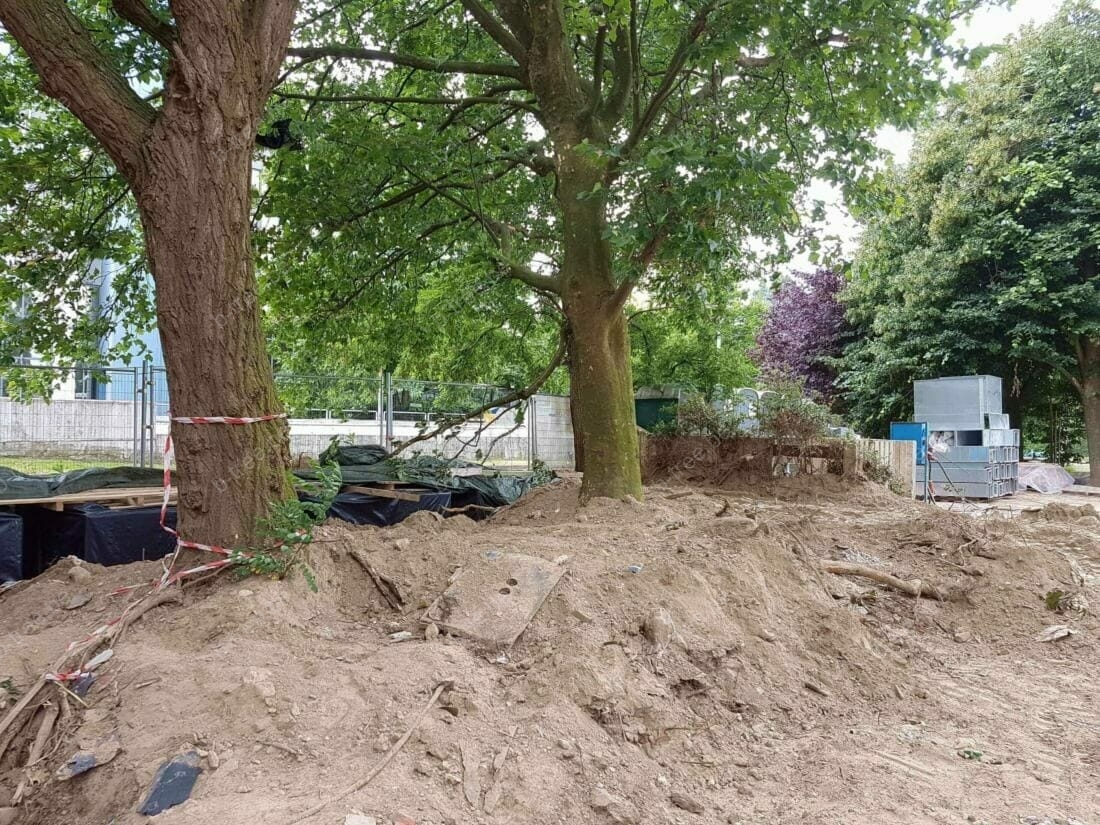
Because no tree protection was provided during this construction site, the roots of both trees were dug away on both sides. The bottom is also severely damaged.
Paving work
Building roads, sidewalks and other paving close to trees can, in addition to physical root damage, also limit root growth. And lead to compaction of the soil. As a result, the rootable soil volume decreases and the tree therefore has a lower future expectation. Generally speaking, a tree needs approximately 1 m³ of root-resistant soil per year. To be able to maintain and develop in a normal way.
Gas exchange between roots and the soil is also hindered by soil compaction.
Disturbance of the soil
Agricultural practices such as plowing, installing drainage or milling the top layer of the soil for lawn construction can damage the root system. Depending on the works and weather conditions (too wet, for example), the structure of the soil can be negatively affected. Both of which have negative consequences for the health of the tree.
Note that many tree species have approximately 70% of their root systems in the top 20 cm of the soil. This means that if you dig 20 cm deep to create a lawn, you have damaged almost all the roots of the tree. And that is also visible above ground; you will clearly see this on the tree in the years to come. Are condition will decrease sharply. The tree will show tip mortality and have fewer leaves.
Planting in the root zone and crown projection of trees
When planting ground covers, shrubs or other trees in the zone around a tree, namely within or up to a few meters outside the crown projection, it is best to take into account that you do not damage the tree's roots that are too large. It is best not to damage roots larger than 2,5 cm. And certainly not if there are multiple roots of this size and from the same tree.
It is then better to move your planting a bit, so that you do not encounter roots that are too large. Or use smaller planting material so that you need less space.
Source drainage
Source drainage is very bad for trees, especially if no preventive measures are taken. Here it is not so much the physical damage initially, but the death of roots due to the lack of water. And afterwards, when the roots have died, the roots can also become rotten. As a result, they lose their mechanical strength and the tree can experience stability problems over time.
Note that the lack of water can be detrimental not only to the roots, but to the entire tree in a short time.
Read all about it well drainage and trees on our specially written page.
Natural factors
In addition to human factors that cause root damage to trees, there are of course also natural factors that can cause trees to suffer root damage.
Often you have no control over this unless you... Have trees inspected for defects and the necessary measures have been taken.
That does make a difference. For trees with a crown that is too one-sided, for example, we will advise you to prune them by taking in the crown. So that the tree has less chance of being uprooted.
Extreme weather conditions
Prolonged drought, floods, and heavy storms can cause root damage due to dehydration, lack of oxygen, or physical damage from the tree falling.
Erosion
Soil erosion can wash away the upper soil layers, which are rich in nutrients and contain many fine roots. Which affects the growth and stability of trees and the exposed roots dry out and become dysfunctional.
Root competition
In densely forested or overplanted areas, trees can compete with each other for space, water and nutrients. Which can lead to root systems that cannot fully develop or become damaged, for example due to pinching.
Infestation by diseases and pests
Certain soil pests and root diseases (caused by fungi or bacteria) can attack the roots, causing them to weaken, become dysfunctional or die.
Understanding the causes of root damage is crucial for developing effective strategies and measures to protect and conserve trees. Both in urban environments and in natural ecosystems.
Preventive measures and careful management by experts, such as a tree manager, are essential to ensure the health and longevity of your trees.
Prevention and prevention of root damage in trees
Prevention of root damage involves a variety of approaches.
Including selecting suitable locations for tree planting to avoid conflicts with infrastructure. Or the use of protective barriers around the root zone of existing trees during construction work. Or regular watering when using well drainage, so that the trees within the area of influence of the drainage are not damaged.
Everything to keep the tree roots and the tree itself in good condition and health. And to ensure that existing and new trees have development opportunities through the underground and above-ground space made available to them, without permanent root damage being caused.
In addition, installing deep edge foundations can prevent roots from gaining access beneath foundations, preventing damage to both trees and structures (Day, 1991). In addition, strategies such as providing sufficient space for root growth under pavement and reducing pavement load due to root growth can help prevent damage (G. Watson et al., 2014).
Understanding the morphological and physiological effects of root damage and implementing preventive measures are essential for maintaining healthy and stable trees. In both urban and natural environments. And also protect the structures such as the pavement and buildings near the trees.
Preventing root damage to trees requires a specialized approach. Where the expertise of a tree expert is indispensable.
Below you can read about the tasks of a tree expert and the important components of tree protection plans, transplantability studies and rooting studies.
Example of prevention; test trench for root research
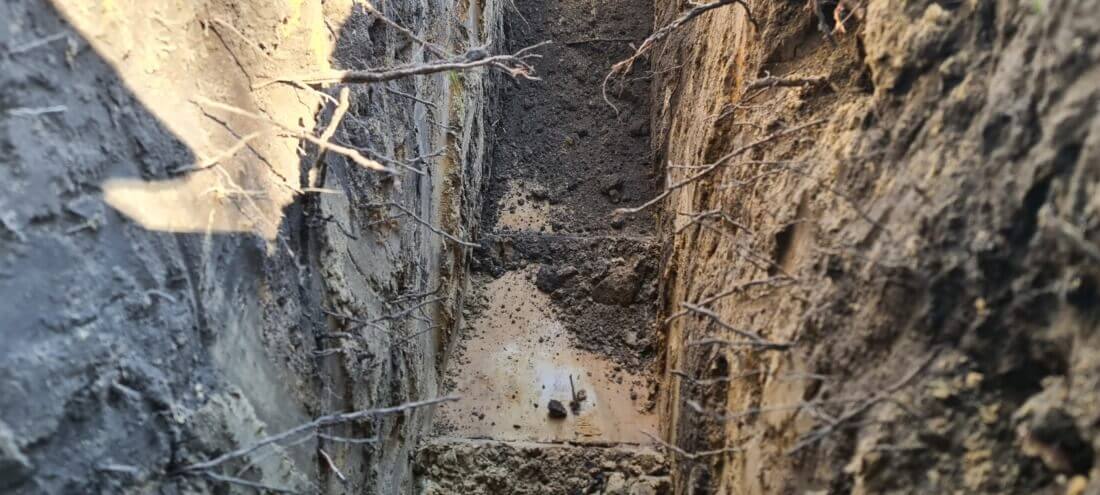
Test trench made during preliminary root research to check whether there are no roots that are too large. So that no root damage is caused during excavation work. In the image you can see that there are indeed only small roots present. Which means that from this location on the site, and further away from the tree, digging can be done for civil constructions and buildings.
Task of a tree expert to prevent root damage to trees
A tree expert plays a crucial role in preventing root damage by conducting surveys and drawing up the necessary measures and working practices. There are several standard options. However, every situation is specific and often requires a tailor-made approach.
Drawing up a tree protection plan
This plan identifies and protects existing valuable trees during construction and development projects. It includes measures to protect trees, their branches above ground and their roots below ground against mechanical damage, soil compaction, and changes in the soil water regime.
It provides 3D protection and protection over time, using good planning, appropriate working practices and protection measures, to ensure that the trees are healthy and damage-free throughout the project.
Carrying out a transplantability study
This study assesses whether a tree can be moved without causing significant damage. It takes into account the health, age, species and location of the tree and its future destination location. It is always for this root research necessary to know whether the tree can be transplanted and how large the root ball of the transplanted tree will need to be.
Carrying out a rooting study
This examination evaluates the condition, structure, location and size of the roots. And it shows the structure of the soil layers, the soil type and where the groundwater table is located in relation to the roots of the tree. So that in addition to data from the roots, there is also data about the groundwater profile on which the tree absorbs water.
This research is always necessary when trees are confronted with well drainage, where trees often have to be irrigated.
Drawing up a tree effect analysis
This research examines the effect on existing trees in an environment where civil works, such as construction work, will take place. And what must be taken into account during the design phase to protect iconic and preserved trees from root damage and above-ground damage.
De Tree Effect Analysis or BEA is nowadays almost always a requirement of government roads, as part of an environmental permit, especially when there are valuable trees on the site or in larger projects. In addition, this research also ensures that the already green environment of the project is maintained in a high-quality manner in the long term. Which is very valuable, both in terms of experience and financial value.
Components of a tree protection plan
A tree protection plan from b-Tree Tree Care contains at least the following elements:
Inventory of trees
Identification, planting and assessment of all parameters (such as condition, vitality, damage, defects and other problems) of the trees on the site. This part of the report is also used as a baseline measurement if damage was subsequently caused to trees during the construction work, to estimate and assess tree damage.

Print screen of a part of the tree database, linked to the tree inventory via the GIS system.
Assessment of the impact
This section contains the study and analysis of how planned activities can affect the trees. And what measures should be taken. The earlier we can be involved in the project as a tree expert, the less time and money is lost, because decisions can then be made “right first time”. Up to this point, this study largely parallels the Tree Effect Analysis.
Protective measures
A study is first made of the BVZ (tree anchorage zones) and TBBZ (tree zones to be protected), so that protection zones around the trees can be established at the correct locations.
We also specify tree-saving techniques and working procedures to effectively protect the trees against root damage and above-ground damage to the crown structure.
One of the tree-saving techniques is the use of compressed air (airspade technique) or a soil vacuum truck to expose roots without damage. But there are also many other things involved. As irrigation and monitoring of soil moisture when using well drainage for example.

Using an air spade, blow the roots free of debris at the level of utility lines, to make the soil suitable for root penetration again in preparation for a growing area layout and to ensure that there is no damage.
Time planning, follow-up and monitoring
Planning of the project and construction activities is necessary to minimize the impact of the works on the trees and the damage that the trees could sustain as a result. Tree roots experience the least damage if the soil only needs to be touched once, and after preliminary research, and new small roots can quickly form. Poor planning or carrying out work at the wrong time, for example by draining the soil vigorously and for a long time during the growing season, has a negative impact on the trees.
All work must of course be monitored by a tree expert, so that you can be assured of correct execution and compliance with the prescribed working methods and protection measures. Unexpected events or obstacles in the project can also be anticipated quickly and correctly. In addition, regular monitoring of the condition of the trees during the project is necessary. Because this provides feedback on the correct functioning of the measures taken.
Components of a transplantability study
A transplantability study includes at least:
Health and vitality assessment
Evaluating the current health and growth potential of the tree. This is important to know, because you do not want to invest in a tree that shows stagnation, is not in good condition or is not vital. Because you should know that a transplant is a nice investment.
Root system assessment
Inspection of the structure and condition of the root system. At the transplanting a tree you need to determine the size of the root ball, and it must be large enough to give the tree the greatest possible chance of survival. But the root ball cannot or should not be too large, otherwise it will be difficult to move or transport by road will be impossible. For this you need to collect the necessary information about the root system of the tree to be transplanted.
The way in which the tree provides itself with water (continuous groundwater profile, suspended water profile, apparent groundwater profile, etc.) must also be known in order to know whether the tree will be able to reach its destination and what aftercare needs to be given in the years afterwards. .
Location analyses
Research into current and future site conditions. When you transplant, you have a starting location and a destination location. The qualitative properties of the two locations or growing areas may not differ too extremely from each other. And the destination location must certainly be suitable.
Transplanting methodology
Recommendations for transplanting techniques and procedures. This is the collection of the different methods that can be used to effectively remove the tree from the ground, clump it and move and transport it.
Aftercare plan
Strategies for management and maintenance of the tree after transplanting. Do not forget to irrigate the tree. Because it has lost many roots, making it less easy for it to absorb water.
Components of a rooting study
A rooting study typically contains the following elements:
Root morphology data
Research into the shape, size and spread of the root system. When carrying out projects near trees, it is important to know where their roots are located and how big they are. Depending on this, it can be determined whether structures such as buildings can be realized further away or closer.
Root health
Assessment of the health and function of the roots, including the presence of diseases or pests.
Soil conditions
Analysis of soil structure, texture, moisture, composition and fertility.
Water management
Assessment of water availability and dynamics in relation to the root zone.
Management recommendations
Strategies to optimize growing conditions and improve root system health.
Structure of Trees Effect Analysis report
This analysis aims to understand the effects of various factors on trees and analyze the impact of trees on their environment. Below is an explanation of which components often appear in this type of analysis, although this will also depend on the specific goals of the analysis:
Inventory and visual inspection
This is the act of visually assessing the tree for signs of disease, pests, structural problems, or other stressors that could affect the health or safety of the tree.
Growing conditions
Analysis of soil, water availability, light, and other environmental factors that affect tree growth and health.
Tree structure
Assessment of the structural integrity of the tree, including the trunk, branches and root system, to identify potential risks such as breakage or toppling.
Disease and pest assessment
Identification of diseases and pests that can affect the tree. This includes recognizing symptoms and determining the severity of the attack.
Impact analysis
Evaluation of how the tree interacts with its environment, such as the influence on underlying or surrounding infrastructures (e.g. buildings, roads) and vice versa. And the contribution the trees make to the ecosystem (e.g. habitat for animals, air quality).
As a result, you know which trees are best preserved and which trees you can possibly keep. Or which ones must be removed because they completely conflict with the project, are no longer safe and are not trees for the future. So that they better make room for the project or form a suitable place for a new one to plant a future tree.
Risk assessment
Assessment of the risk a tree poses to its environment through its current health and structure. This is especially important in urban and sub-urban areas.
Management and maintenance plans
Develop recommendations for tree maintenance and management to improve health and reduce risks.
Historical data
Analysis of previous maintenance records, growing conditions, and previous interventions to identify trends and patterns in tree health.
As tree experts, we use these studies and plans to make informed decisions that ensure the health and stability of trees. While the risks of root damage are minimized. This ensures a balanced coexistence of trees and human activities in both urban and natural environments.
Preventing root damage to trees during earthworks and garden construction
Preventing root damage to trees during earthworks and garden construction is essential for several reasons, as you could read above. However, it happens very frequently, probably due to ignorance.
Why prevent root damage
In addition to the morphological and physiological reasons for preventing root damage in trees, there are also a number of other factors that you should take into account.
Protection of the (tree species specific) ecosystem
Trees play a key role in their ecosystem by providing habitat and food for insects, animals, fungi and many other organisms. And in maintaining soil quality and supporting biodiversity. Damage to roots will reduce these ecological benefits. And it not only disrupts the tree species' own ecosystem, but also the larger ecosystem.
Preventing additional costs
Damaged trees will lead to tree care interventions, such as an increasing frequency of tree inspections, safety pruning or replacement. And possibly even liability issues if a weakened tree causes damage to property or persons.
Water management and conservation
Healthy tree roots help manage stormwater, reduce erosion and can help reduce flood risks. Tree growing areas can buffer a lot of water and ensure less water run-off.
Preservation of the aesthetic value
Trees contribute to aesthetic value and overall well-being in both urban and rural environments. They provide many ecosystem services. Maintaining the health and vitality of trees, among other things by avoiding root damage, is important for maintaining landscape value and living environment quality.
Regulation of the climate
Trees play a crucial role in regulating the climate by absorbing CO2, producing oxygen and providing shade and coolness, which helps regulate ambient temperatures.
For these reasons, it is important that earthworks and landscaping are carried out carefully. With great respect for the existing trees and their root systems. To ensure their continued contribution to the ecosystem services they provide.
By carefully integrating trees into your project, they... protection during construction work and therefore avoid root damage, you contribute to the preservation and creation of a natural green or park environment.
How to physically protect trees against root damage in their crown projection?
Physically protecting trees in their root zone and protecting them from entering this zone is essential to prevent root damage. These are some effective methods that work:
Barriers or barriers
Place physical barriers such as fences or barriers around the tree's critical root zone (TBBZ), which often extends to the drip line of the tree crown and even beyond. This prevents direct entry and mechanical damage from vehicles, heavy machinery or intensive pedestrian activity. It also prevents uncontrolled and irregular work in the soil around the tree.
Ground cover
Use organic mulch, such as wood chips or bark, to create a protective layer over the root zone. This reduces soil compaction from foot traffic, helps retain moisture, and provides a visual cue to avoid the area. Make sure that the mulch is not directly against the trunk to prevent moisture problems and diseases.
Road plates
If there is a temporary need for heavy traffic in the vicinity of trees, use road plates to distribute the pressure on the ground and minimize root damage. Ensure that the road plates are placed and removed carefully to avoid disturbing the roots. Also use suitable road plates; heavy transport is only possible when using heavy and thick steel row plants. Plastic road plates do not provide sufficient protection here. These are only suitable for lighter traffic such as wheelbarrows, pedestrians, lighter machines up to, for example, 500 kg.
Manual work in the root zones
Do not allow mechanical soil cultivation in the root zones around trees. Because all too often a lot of damage is caused by machining the soil. For example, by milling the top layer of the soil you will cause serious root damage. Use compressed air techniques such as an air spade to loosen soil and level it with hand tools such as a rake.
Elevated walkways and platforms
In areas with high pedestrian traffic, consider installing raised walkways or platforms that rise above the root zone. This reduces direct impact on the soil and protects the underlying root zones.
Awareness, sensitization and education programs
Developing awareness programs, sensitization campaigns and educational materials for the community and workers on construction sites can help emphasize the importance of protecting tree roots. Educating yourself about the sensitivity of root zones and encouraging respectful behavior can reduce physical damage.
Regular monitoring and maintenance
Regular inspections of the protected areas around trees ensure that the preventive measures remain effective. And not be circumvented or damaged. Quick repairs or adjustments to protective measures ensure uninterrupted protection.
Implementing these measures requires careful planning and investment. But the long-term benefits to the health and longevity of trees are significant. Protecting the root zone is an essential part of good tree management and landscape conservation and preventing root damage to trees.
